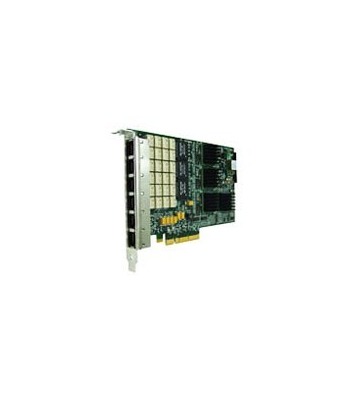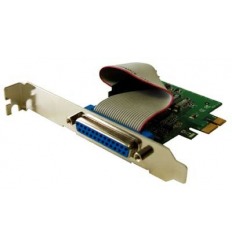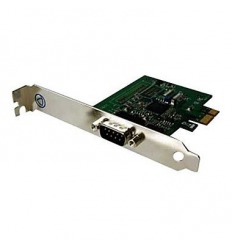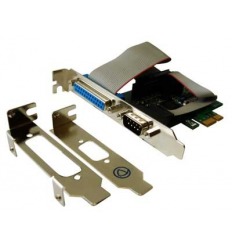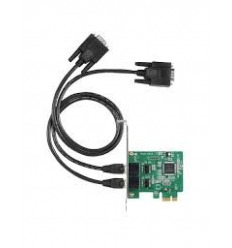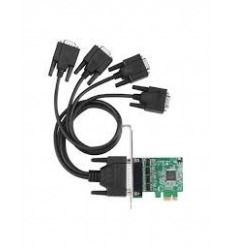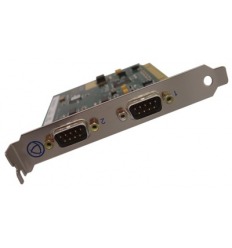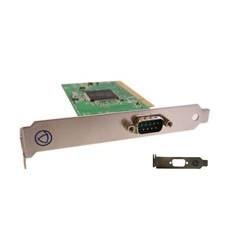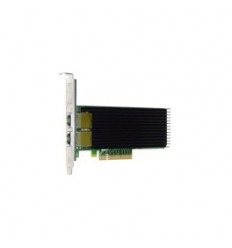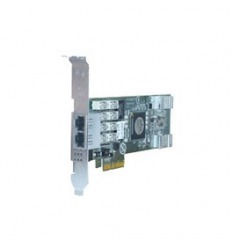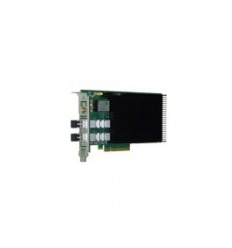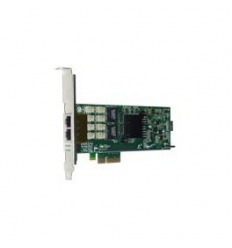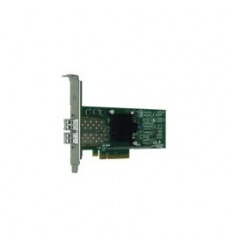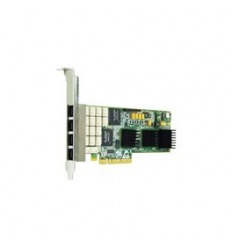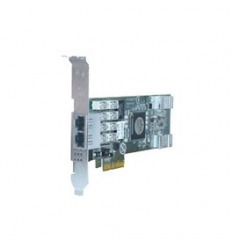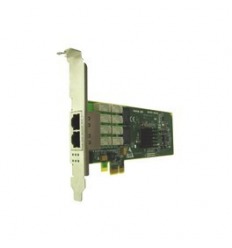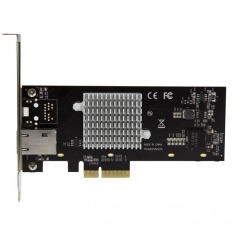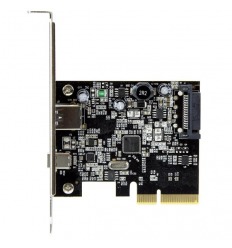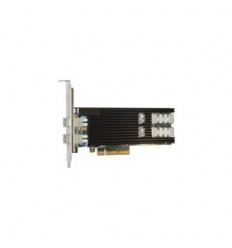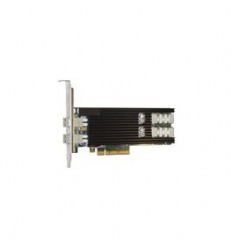Silicom’s Six Port Gigabit Ethernet Bypass server adapter is a 8 lanes PCI Express network interface card that contains six independent Gigabit ports on one PCI Express adapter. Silicom’s Six Port Gigabit Ethernet PCI Express Bypass server adapter supports Normal, Bypass and Disconnect modes.
In Normal mode, the ports are independent interfaces. In Bypass mode, all packets received from one port are transmitted to adjacent port. In Disconnect mode, the adapter simulates switch / rout cable disconnection.
- Silicom’s Six Port Gigabit Ethernet Bypass server adapter is a 8 lanes PCI Express network interface card that contains six independent Gigabit ports on one PCI Express adapter.
- Silicom’s Six Port Gigabit Ethernet PCI Express Bypass server adapter supports Normal, Bypass and Disconnect modes.
- In Normal mode, the ports are independent interfaces. In Bypass mode, all packets received from one port are transmitted to adjacent port. In Disconnect mode, the adapter simulates switch / rout cable disconnection.
- In Bypass mode, the connections of the Ethernet network ports are disconnected from the interfaces and switched over to the other port to create a crossed connection loop-back between the Ethernet ports. Hence, in bypass mode all packets received from one port are transmitted to other port and vice versa. This feature enables to bypass a failed system and provides maximum up time for the network.
- In Disconnect mode, the adapter simulates switch / router cable disconnection. In Disconnect mode, the switch / router does not detect link partner of the adapter.
- Silicom’s Gigabit Ethernet Bypass server adapters include an on board WDT (Watch Dog Timer) controller. The adapter’s software drivers or software application can write commands to the on board WDT controller. The adapter’s software drivers, WDT controller and the Bypass circuitry provide an interface that control and manage the mode of the adapter.
Bypass:
- Bypass / Disconnect Ethernet ports on Power Fail, System Hangs or Software Application Hangs
- Software programmable Bypass, Disconnect or Normal Mode
- On Board Watch Dog Timer (WDT) Controller
- Software programmable time out interval
- Software Programmable WDT Enable / Disable counter
- Software programmable Bypass Capability Enable / Disable
- Software Programmable Disconnect Capability Enable / Disable
- Software Programmable mode (Bypass, Normal or Disconnect mode) at Power up
- Software Programmable mode (Bypass, Normal mode) at Power off
- Independent Bypass operation in every two ports
- Emulates standard NIC
Copper Gigabit Ethernet 1000GBASE-T:
- Independently copper Gigabit Ethernet channels support six, four, two and one Gigabit Ethernet (1000Base-T), Fast Ethernet (100Base-Tx) and Ethernet (10Base-T)
- Triple speed 1000Mbps (1000Base-T), 100 Mbps (100Base-Tx) and 10 Mbps
(100Base-T) operation - Nway auto negotiation automatic sensing and switching between 1Gbps full duplex and 100 / 10 Mbps operations Simplex or Full Duplex
- RJ-45 female connectors
Common Key features:
- Host Interface standard support PCI Express 1.0a:
- High performance, reliability, and low power use in Intel 82575 dual integrated MAC + PHY and SERDES chip controller
- Ultra deep packet buffer per channel lowers CPU utilization
- Hardware acceleration that can offload tasks from the host processor
- The controllers can offload TCP/UDP/IP checksum calculations and TCP segmentation
- Priority queuing – 802.1p layer 2 priority encoding
- Virtual LANs –802.1q VLAN tagging
- Jumbo Frame (9.5KB)
- 802.x flow control
- Statistics for SNMP
- LEDs indicators for link/Activity/Bypass/Disconnect Mode status
|
Bypass Specification: |
|
|
WDT Interval (Software Programmable): |
3,276,800 mSec (3,276.8 Sec): Maximum WDT Interval = (2^wdt_interval_parameter)*(0.1) sec. |
|
Copper Gigabit Ethernet Technical Specifications - (1000BASE-T) Adapters: |
|
|
IEEE Standard / Network topology: |
Gigabit Ethernet, 1000Base-T |
|
Full duplex / Simplex: |
Support both Simplex & Full duplex operation in all operating speeds |
|
Auto negotiation: |
Auto-negotiation between Full duplex and simplex operations and between 10Mb/s 100Mb/s speeds and duplex 1000Mb/s |
|
Data Transfer Rate:
|
1000 Mbit/s, 100 Mbit/s and 10 Mbits/sec in simplex mode per port. |
|
Cables and Operating distance: |
10Base-T Category 3, 4, or 5 maximum 50m * |
| Operating Systems Support | |
| Operating system support: | Windows Linux FreeBSD VMware |
| General Technical Specifications | |
| Interface Standard: |
PCI-Express Base Specification Revision 1.0a |
| Board Size: |
PCI Short add in card: 167.64mm x 106.68mm (6.6”X 4.2”) |
| PCI Express Card Type: | X8 |
| PCI Express Voltage: |
+3.3 ± 9%, |
| PCI Connector: |
Gold Finger: X8 |
| Controller: : |
Intel 82575EB |
| Holder: |
Metal Bracket: Full Height: Appendix B |
| I/O: | Located on the metal bracket |
| Weight: |
180 gram (6.35oz) |
| Power Consumption: | Normal mode: 13 W, 2.24 A at 3.3V and 0.46 A at 12V : Typical all ports operate at 1000Mbit/s. 8.15 W, 1.11 A at 3.3V and 0.37 A at 12V: Typical all ports operate at 100Mbit/s. 7.5 W, 1.01 A at 3.3V and 0.34 A at 12V: Typical all ports operate at 10Mbit/s. 6.75 W, 0.76 A at 3.3V and 0.35 A at 12V: Typical No link at all ports. Bypass mode: 6.6 W, 0.76 A at 3.3V and 0.34 A at 12V |
| Operating Humidity: | 0%–90%, non-condensing |
| Operating Temperature: | 0°C – 50°C (32°F - 122°F) |
| Storage: | -20°C–65°C (-4°F–149°F) |
| EMC Certifications: |
FCC Part 15, Subpart B Class B |
| MTBF*: | 64 (Years) *According to Telcordia SR-332 Issue 1 Environmental condition – GB (Ground, Fixed, Controlled). Ambient temperature - 25°C. Temperature rise of 15°C above the system ambient temperature was assumed for the cards components |
| LEDs | |
| LEDs: |
(4) LEDs per Bypass pair: ( total of 12 LEDs) |
| LEDs location: | LEDs are located in the RJ45 |
| Connectors: | (6) Shielded RJ-45 |
Part Code:
PEG6BPi5
- APC
- Arista
- Aruba
- ATEN
- Austin Hughes
- Aviosys
- Avocor
- Bailey
- BenQ
- Black Box
- Brother
- Cadyce
- Cisco
- Cramer
- Crestron
- Cyber Power
- Dell
- Digi
- DTEN
- Eaton
- Enconnex
- EPSON
- Extreme Networks
- Gefen
- Geist
- Heckler Design
- HPE
- IBM
- IXIa
- iXsystems
- Juniper Mist
- Kaminario
- Kramer
- Lantronix
- Lenovo
- Linksys
- Logitech
- Luxor
- Mellanox Technologies
- Microsoft
- MINICOM
- Moxa
- MRV
- Napatech
- Neat
- NetApp
- NETGEAR
- Nimble
- NTI
- NVIDIA
- OpenGear
- Panasonic
- Perle
- PlenaForm Systems
- Pure Storage
- Qnap
- Quantum
- Raritan
- RF Code
- Samsung
- Seagate
- Sensaphone
- ServerLIFT
- ServerTech
- Silicom
- Solarflare
- Sony
- StarTech
- Sun Microsystems
- Supermicro
- TDK
- Thinklogical
- TRENDnet
- TURTLE
- Vertiv
- Wacom
- Yubico
- Zoom
- ZPE Systems

